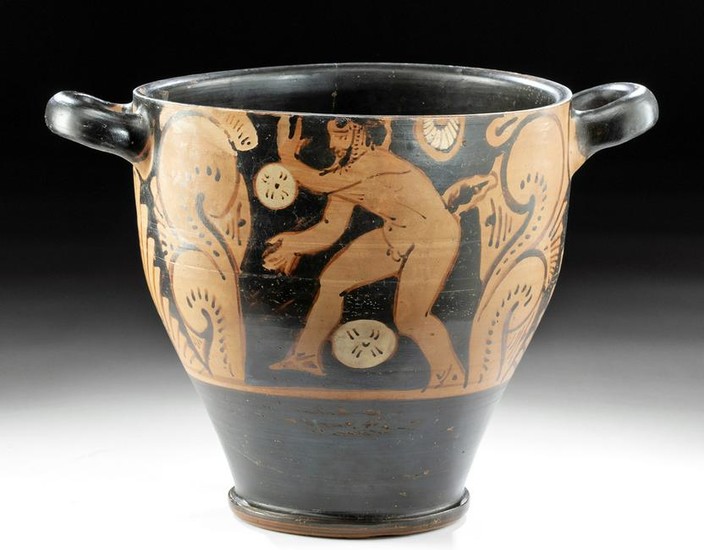Large Faliscan Red Figure Skyphos - Satyr & Maenad
Italic, Faliscan, ca. 325 to 300 BCE. A mesmerizing red-figure skyphos of a very large and deep form - voluminous enough for mixing wine - with twin horizontal loop handles. The iconographic program is Dionysian (Roman Bacchic) in nature, quite apropos for this wine vessel, featuring a maenad on one side and a satyr on the other. The maenad stands in composite profile moving toward the left with outstretched arms as if dancing and draped in a flowing chiton. Fugitive (added) white pigment is used for her face, arms, and feet to delineate her complexion. The satyr also motions to the left with arms in a dynamic pose as if dancing as well. White circular motifs decorate the field. Beneath each handle is a large stylized palmette framed by volutes. A very rare example! Size: 13.25" W handlespan x 9.25" H (33.7 cm x 23.5 cm)
Perhaps the most exciting innovation in Greek vase painting was the red-figure technique, invented in Athens around 525 BCE and beloved by other artists of Magna Graecia as well as Faliscan vase painters. The red-figure technique allowed for much greater flexibility as opposed to the black-figure technique, for now the artist could use a soft, pliable brush rather than a rigid metal graver to delineate interior details, play with the thickness of the lines, as well as build up or dilute glazes to create chromatic effects. The painter would create figures by outlining them in the natural red of the vase, and then enrich these figural forms with black lines to suggest volume, at times perspectival depth, and movement, bringing those silhouettes and their environs to life. Beyond this, fugitive pigments made it possible for the artist to create additional layers of interest and detail as we see in this example.
Provenance: private New York, New York, USA collection; ex private collection V.B., Munich, Germany, acquired from Bernd Gackstatter, Frankfurt, 2000; ex collection of Professor Goring. Included is a letter stating authenticity in German from Gackstatter.
All items legal to buy/sell under U.S. Statute covering cultural patrimony Code 2600, CHAPTER 14, and are guaranteed to be as described or your money back.
A Certificate of Authenticity will accompany all winning bids.
We ship worldwide to most countries and handle all shipping in-house for your convenience.
#153107 Dimensions: Condition Report: Professionally repaired from a few large pieces with nicks and slight fill at break lines. Note that the figures heads appear to be slightly cut off; this probably happened because the Faliscan artist was modeling his work upon that of the Greeks and must have misjudged his spacing and ran out of room. How endearing!
View it on
Estimate
Time, Location
Auction House
Italic, Faliscan, ca. 325 to 300 BCE. A mesmerizing red-figure skyphos of a very large and deep form - voluminous enough for mixing wine - with twin horizontal loop handles. The iconographic program is Dionysian (Roman Bacchic) in nature, quite apropos for this wine vessel, featuring a maenad on one side and a satyr on the other. The maenad stands in composite profile moving toward the left with outstretched arms as if dancing and draped in a flowing chiton. Fugitive (added) white pigment is used for her face, arms, and feet to delineate her complexion. The satyr also motions to the left with arms in a dynamic pose as if dancing as well. White circular motifs decorate the field. Beneath each handle is a large stylized palmette framed by volutes. A very rare example! Size: 13.25" W handlespan x 9.25" H (33.7 cm x 23.5 cm)
Perhaps the most exciting innovation in Greek vase painting was the red-figure technique, invented in Athens around 525 BCE and beloved by other artists of Magna Graecia as well as Faliscan vase painters. The red-figure technique allowed for much greater flexibility as opposed to the black-figure technique, for now the artist could use a soft, pliable brush rather than a rigid metal graver to delineate interior details, play with the thickness of the lines, as well as build up or dilute glazes to create chromatic effects. The painter would create figures by outlining them in the natural red of the vase, and then enrich these figural forms with black lines to suggest volume, at times perspectival depth, and movement, bringing those silhouettes and their environs to life. Beyond this, fugitive pigments made it possible for the artist to create additional layers of interest and detail as we see in this example.
Provenance: private New York, New York, USA collection; ex private collection V.B., Munich, Germany, acquired from Bernd Gackstatter, Frankfurt, 2000; ex collection of Professor Goring. Included is a letter stating authenticity in German from Gackstatter.
All items legal to buy/sell under U.S. Statute covering cultural patrimony Code 2600, CHAPTER 14, and are guaranteed to be as described or your money back.
A Certificate of Authenticity will accompany all winning bids.
We ship worldwide to most countries and handle all shipping in-house for your convenience.
#153107 Dimensions: Condition Report: Professionally repaired from a few large pieces with nicks and slight fill at break lines. Note that the figures heads appear to be slightly cut off; this probably happened because the Faliscan artist was modeling his work upon that of the Greeks and must have misjudged his spacing and ran out of room. How endearing!



